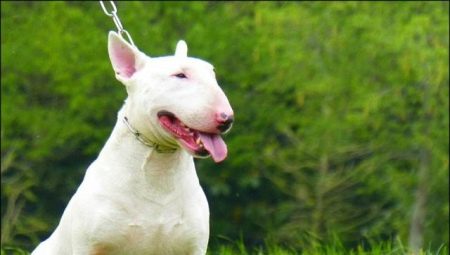Miniature bull terriers belong to the decorative species of dogs and are often found in the United States, England and Russia. From their relatives - bull terriers, they differ in a more active and stubborn disposition, as well as a small growth, which allows them to keep these dogs in city apartments. This article will discuss miniature bull terriers: the features of their exterior, the intricacies of feeding and keeping.
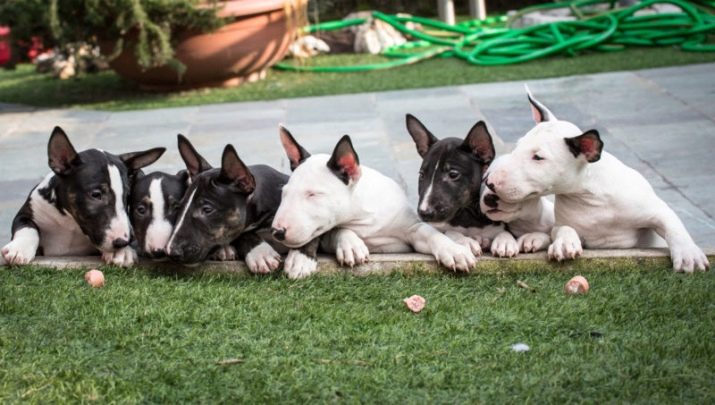
Origin history
This variety of bull terriers is relatively young - it appeared only in the second half of the XIX century. The initiator of the breed itself was the English breeding breeder James Hinks. He was fascinated by the power of the bulldog and the grace of a white British terrier and strove to create a dog breed with common qualities. Some sources also report that Dalmatians, hounds, and greyhounds also participated in breeding experiments with these dogs.
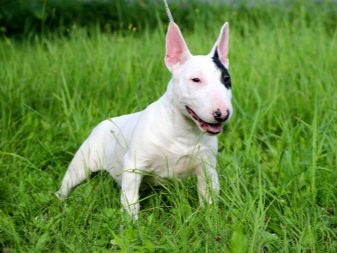
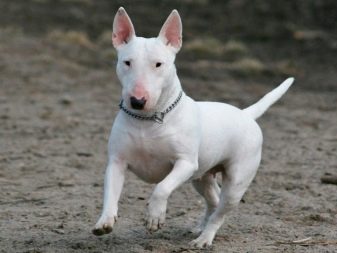
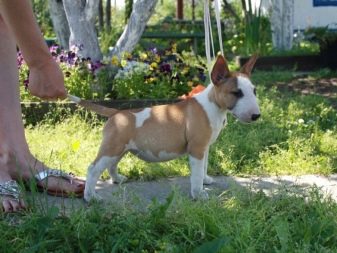

The breeding research of the breeder lasted about 10 years, and their result was the presentation of the first representative of the breed at the exhibition in 1862. The presented individuals, which received the name of the white bull terrier, unlike their congener of the bull and terrier, had a more elongated graceful body, an elongated oval head, smooth lips and dense elastic skin. In addition, despite the grace and elegance of the new breed, Hinks was able to preserve in it the best features from fighting dog breeds - a remarkably developed muscular system, powerful jaws and fangs.
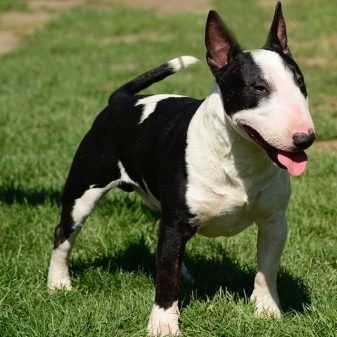

In addition to their external qualities, white bull terriers had a cheerful and active character, a hardy and strong body, as well as cleanliness and a sharp mind. Representatives of this breed were so wildly successful that at the end of the 19th century among the teaching and student body of Oxford it was considered noble and elite to have a purebred white bull terrier at their disposal.
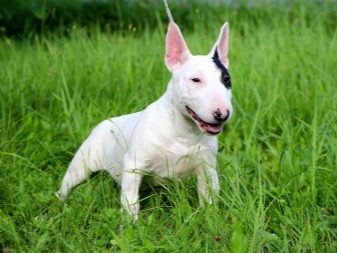

Official recognition came to the bull terriers only at the end of the XIX century. The first to do this was the American Kennel Club. Thanks to the activities and support of this club, by the beginning of the twentieth century, bull terriers of not only white, but also other colors began to be allowed to exhibitions.
The history of miniature bull terriers begins in the period of active breeding experiments conducted by Hinks in the middle of the XIX century. During his many experiments, dozens of different breeds of dogs were used, which once led to the birth of white bull terriers of an absolutely identical standard, but smaller and smaller. Initially, these individuals were rejected or simply sold at reduced prices, but soon even in the litter of purebred white bull terriers, miniature dogs began to be born. Very soon the breeder decided to separate this breed of dog into two types: standard (large) and mini (miniature). If the bull terriers were designated by the American Club of Dog Breeding as a representative of the fighting breed, then the status of a purely decorative appearance was assigned to the miniature individuals.
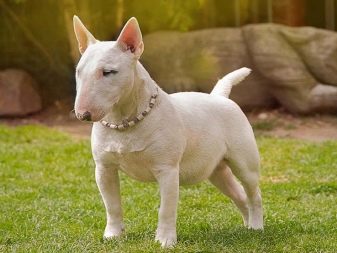
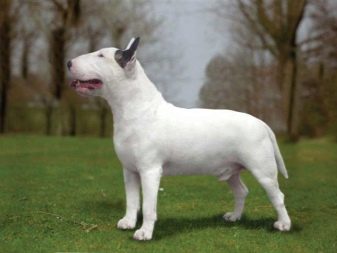
Miniature bull terriers, although they were not as popular as the standard type, also received their share of popularity. They began to be used as ordinary companions and rat-catchers - due to their small stature and developed limbs, these dogs could get to those corners where standard-type individuals could not get.
Do not think that the development of the dwarf type has stopped on the division of this breed into large and small boules. Even the segmentation of the breed did not help to cope with the flow of miniature babies, which significantly differed in size even from each other. There was a need to unify all miniature individuals, for which they soon began to use the genetic material of toy terriers. This helped, and the growth problem gradually disappeared, but a completely new one was formed - the features of terriers began to prevail in these individuals, and the backbone of the new breed was weaker each time, as was the average weight. Individuals were born weak and hardly viable. Thanks to annual experiments, it was possible to create the perfect version of the mini-bull terrier, whose representatives we meet today.
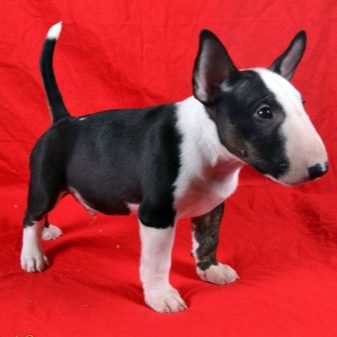

Breed description
Both types of bull terriers have approximately the same and incredibly memorable exterior, thanks to which they can be easily distinguished among all other dogs. The key difference between bulls from other breeds is an ovoid head, lack of foot and small, wide-set eyes. Below will be presented the general standard of the bull terrier breed, adopted by the IFF and upgraded to a dwarf variety of bulls.
- Average weight. Adults should weigh no more than 15 kg (males). Females weigh slightly less than males - up to 12-13 kg.
- Medium height at the withers. Both males and females of mini-bull terriers should be no higher than 35 and not lower than 25 centimeters. Inexperienced breeders believe that the lower the growth of these dogs, the better, but in this case, the proportionality of the body is violated. The apparent disproportionate growth and size of the dog leads to various diseases - the main load in this case goes to the skeleton and the cardiovascular system.
- Life span. Bull terriers usually live no longer than 14 years (at best), and mini-bulls often survive to 15 or more.
- Body. The body of the bullae is incredibly compact and massive, muscular, has a flat back, a wide chest with developed relief muscles.Croup is smooth and rounded, poorly visible.
- Head. Large, ovoid type, skull elongated, widened between the ears. Stop is completely absent due to the extremely wide nose bridge, which evenly passes into the muzzle.
- Nose. Large and wide, well developed. Usually black, but pigmentation in other shades is acceptable.
- Neck. Medium length, but large and strong. Folds on the sternum or neck are absent.
- Limbs. Not particularly long, but massive and muscular. The front ones stand straight and parallel (the elbows are pressed to the body), the rear ones are longer and have a slight slope.
- The ears. All bull terriers have large, straight-set ears with rounded tips. Auricles are looking forward.
- Jaws and teeth. From their ancestors, the mini-bulls left very powerful and muscular jaws, which are still able to bite through hard bones without any problems.
- Tail. The same medium length as standard bull terriers, thins from base to tip. It is covered with a thick layer of not short, but hard wool, the tip of colored individuals is usually painted in light color.
- Color. The classic color of bull terriers is considered to be white, which allows partial pigmentation with spots of a different color on the chest and head. In addition to white, red, black, red and brown colors are also recognized. The requirement for the color of these dogs is the dominance of one particular color. Also there are individuals of these dogs with the so-called "tricolor" - several colors in color (brindle, wild boar, swamp). In addition to the colors presented, there are individuals with a golden and blue color, however, such dogs are usually rejected.
- Movement. Despite their small stature and medium-sized limbs, these dogs are capable of very high speed. In the movements of these dogs, both grace and small clubfoot are observed when moving over short distances.
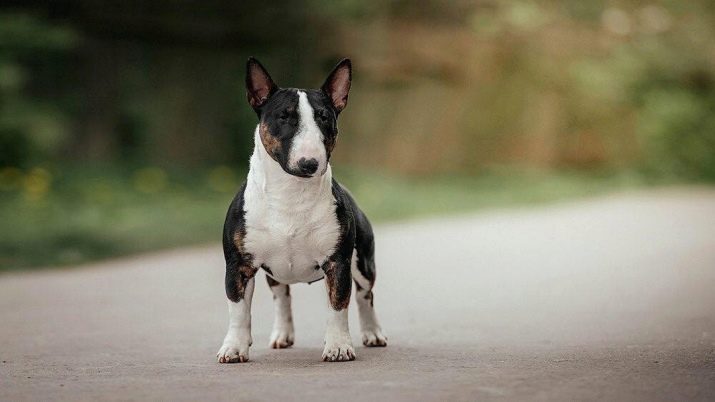

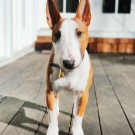
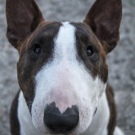

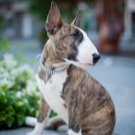
Comparison with a regular bull terrier
This breed of dogs can be easily confused with the standard type of bull terriers, because “mini-bulls” are just one of the varieties of this breed. Speaking quite simply, miniature bull terriers in almost everything are a miniature copy of the standard of this breed. Some dog handlers write that the main difference between miniature bull terriers and their “big” brothers is that they are much more mobile, active and cheerful. In the circles of pedigree clubs, these dogs have gained a reputation for inexhaustible batteries that have the energy for any adventure and adventure. In addition to activity, there is a version that this mini-breed is distinguished by great obstinacy, which often interferes with the training and education of these dogs. However, this is more of a misconception - because of the small size of the dog, its owners often neglect the upbringing of these pets, and therefore capricious and naughty animals grow out of them.
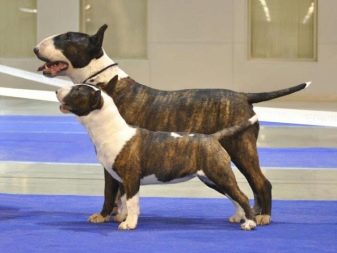
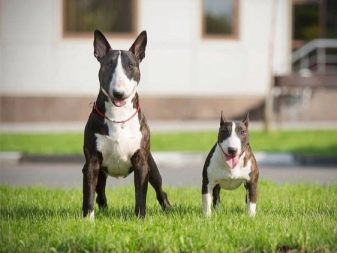
It is believed that miniature boules live a little more than the breed standard. The main reason is a more active lifestyle and a facilitated skeleton. When breeding this breed, a genetic pathology peculiar only to these dogs was discovered - the so-called dislocation of the lens, which can lead to partial or complete loss of vision in dogs in old age. In the procedure of crossing miniature bull terriers with a standard type, puppies are recorded precisely as representatives of a miniature variety, since the presence of this pathology is considered unacceptable among ordinary bull terriers.
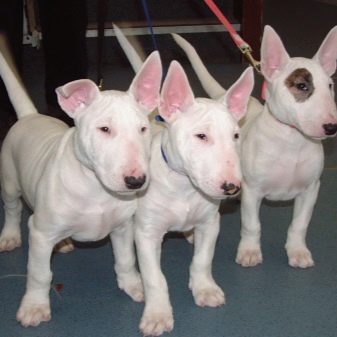
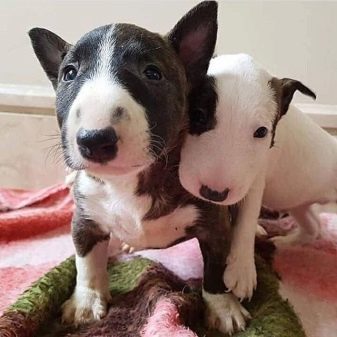
As the last feature of mini-bulls, one can note not so much cost, since these dogs are considered purely decorative and rarely participate in international exhibitions.
Character
In simple words, all miniature bull terriers are choleric to the core. It is difficult to find more active and restless dogs, and therefore not every owner is suitable for them.The owner of a mini-bullet must have an unshakable and strong character, able to keep a pet in control in any situation. But at the same time it should be a cheerful person, able to support the initiative of his pet, his fun, finds and adventures. This dog is not suitable for home-stayers and melancholy - bull terriers need regular walks and physical activitythat are simply unrealistic to arrange at home. Every day for these pets is the opportunity for new discoveries, trainings and games, and if the owner cannot provide them, such dogs become aggressive, capricious and uncontrollable.
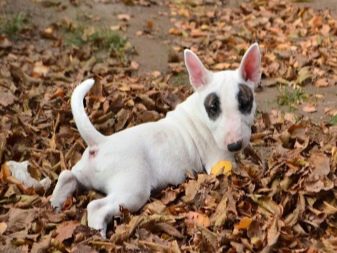
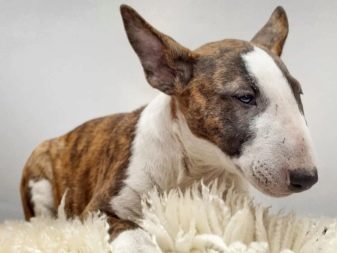
These dogs do not tolerate loneliness very well, this is not the pet that will calmly wait for you from work every day. Alone, the mini-bulb begins to destroy everything that catches his eye. And believe me, when you come home from work and condemn the dog for this misconduct - he will not understand what exactly you are dissatisfied with. These dogs should not be brought to people with a busy schedule and a bunch of daily worries. Let mini-bullets and mischiefs with a stubborn character, but no one has the right to doubt their loyalty to the owner and members of his family.

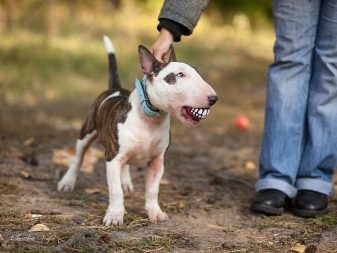
If the owner has managed to prove his authority and supremacy in the relationship, you will not find anyone loyal to these pets. Sometimes their affection comes to the point of absurdity - they want to be near you all the time (even if it is a bathroom, a balcony or you just want to take out the trash). Greetings to these pets will suit you when you return, as if you had not seen each other for many, many years. Most breeders find emotion in such an affection; for others, it causes considerable discomfort, especially if the dog interferes with its presence to work, engage in children or clean the house.

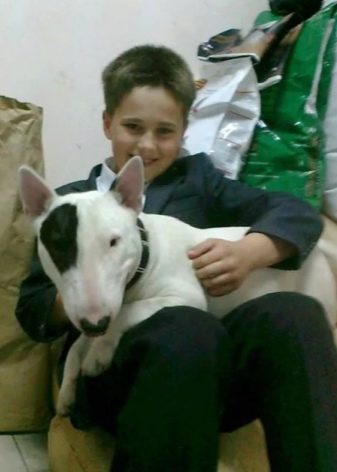
Strangers are afraid to approach the bull terriers, and it’s very in vain - these dogs can hardly be called unequivocally trusting, but they will not refuse good nature. If the stranger behaves appropriately and shows signs of attention towards the dog, the bull will most likely express a desire to meet and even let himself be stroked. These dogs love to communicate with new people, they love new smells and shades.
However, if the bull terrier feels danger from the stranger or notices the owner’s tension, fighting qualities will leap in him instantly. And now in front of you is not a pet, but a bared lump of muscles that will fight for you to the end. A bull will not warn a stranger (grin his teeth or growl), he will immediately rush into battle and it will be difficult to stop him. That is why many people prefer to walk these dogs only in muzzles. Like all dogs with advanced intelligence, mini-bullets feel great about the owner and members of their family. By the expression on their faces, intonation and movements, these dogs are able to determine both joy and sadness. Bull terriers are prone to empathy, and therefore they will be happy if the owner is happy, and tense if the latter is ill.
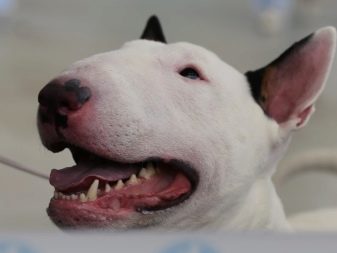
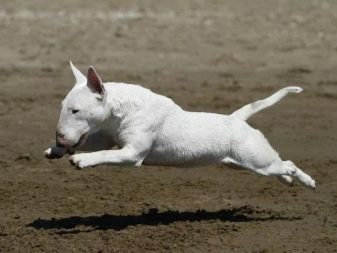
In small family members, bull terriers see not only supporters for fun and games, but also serious competitors for the owner’s attention. The main part of the problems arises when a small child appears in a family with an adult bull and all the attention of the owners switches to the baby. These dogs can not understand for a very long time why the owner’s attention is so attached to the infant, and therefore are able to be capricious or even shut themselves in. To prevent such situations from happening, you should make the pet friends with the child on the very first day of appearing in the house, and try not to belittle your attention to the dog. As soon as the child is a little older, he should be taught to respect the bullet - these dogs do not understand and do not accept teasers and persistent behavior.
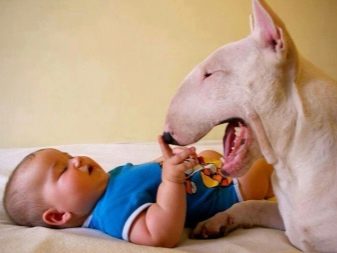
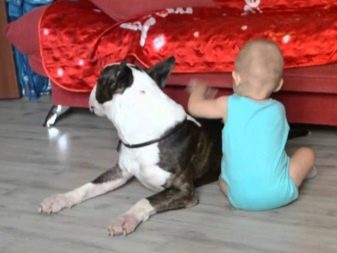
Bull terriers are not particularly rosy about other domestic animals, and if it comes to the attention of the owner, then they can go to the most vile dirty tricks in relation to another pet.Feeling their physical superiority over other domestic animals, these dogs can resort to real tyranny: stealing food from someone else's bowl, intimidation and violation of personal space. To avoid this, you need to try to be equally friendly to the pets, at the same time give them food and stop any terror attempts by any of them. An ideal option would be a house where animals grow together since childhood - in this case, they will surely become good friends and will always protect each other.

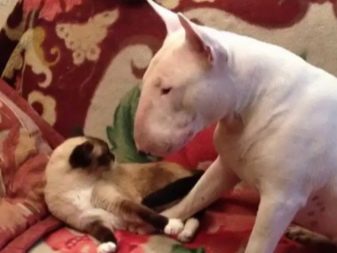
Advantages and disadvantages
There are no definitively good or bad breeds of dogs. Experienced dog handlers are sure that much in the behavior of pets depends on the upbringing and attitude of the owner towards them. However, the mini-bull terriers still entrenched a few common judgments and characteristics, which will be presented below as negative or positive features of this breed of dogs.
Pros.
- Small size. Due to their small size, these dogs can be successfully kept even in the smallest apartment and will not cause the owner any great inconvenience. Small size also means reduced portions of feed.
- Intelligence. No one doubts the intellectual abilities of bull terriers. In the right hands, these dogs can memorize and play even the most difficult tricks very quickly.
- Care. The procedures for caring for these dogs do not differ in any particular complexity. The coat of these dogs does not have the characteristic smell of a dog, in addition, it is quite thin, so these dogs practically do not fade, they do not need to be cut and often combed. All care for these dogs ends with the most common hygiene and prevention: cleaning the ears, cutting off claws, washing the eyes, cleaning teeth from plaque and tartar.
- Power. Despite their small size, dogs of this species are able to show every offender where the crayfish hibernate. They are advised to start them for those who are afraid to walk on the street in the late evenings alone - be sure that no one dares to attack you when you are even a miniature but bull terrier.
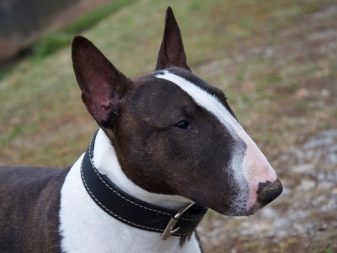
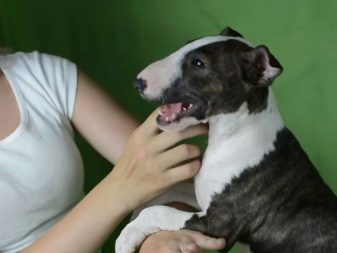
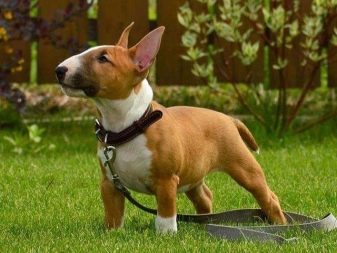
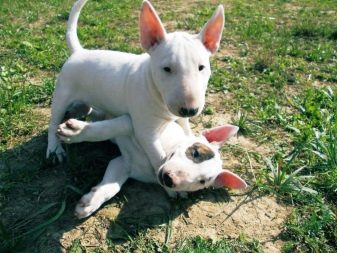
Minuses.
- Reputation. The main disadvantage of this breed of dogs is the attitude of all passers-by and strangers towards it. Walking with these dogs without a muzzle and a collar can end in unpleasant conflicts for you - because of the widespread stereotype of the bloodthirstiness of these dogs, few people trust them. These dogs are unlikely to want to be seen near playgrounds or places of recreation.
- Wool. Short hair is not always a plus in keeping dogs. Because of it, a mini-bull cannot be kept on the street or left in the drafts. The body of these dogs does not tolerate sudden changes in temperature and frost. In addition, for every walk on the street in autumn, winter or early spring, you need to wear a blanket on your pet so that he does not catch a cold.
- Activity. Standard bull terriers themselves are an incredibly active dog breed - they do not like to be in one place for a long time, they love to play with the owner in the fresh air and in the walls of the apartment. Some may think that since mini-boules are smaller than their relatives in size, then there is less agility in them, however, with miniature bull terriers, everything is exactly the opposite. They are twice as fast, agile, more fond of adventures and tomfoolery. Sometimes these dogs can play so hard that they simply cannot be stopped - for families with small children this can be a lot of problems. Kids do not notice when playing with a dog goes beyond entertainment, and the pet, in turn, can forget who it is dealing with. To avoid these incidents in the walls of the apartment, you should constantly load the dog physically - go out with her for jogging, get out into large fields and throw frisbee or balls so that the dog brings them.The best option would be special platforms for training dogs - there are all the necessary simulators for effective exercises.
- Allergy sufferers. Almost all bull terriers are allergic to certain products / plants. It is especially dangerous to walk with such animals in the spring, during the flowering period of many plants. The greatest predisposition to allergies is distinguished by individuals of white color.
- These dogs often suffer from a clear lack of attention., which is aggravated if a new member appears in the family, be it an animal or a person. First, the dog will try by all means to understand what is the reason for the weakening interest in his person, and will attempt to regain attention. If this does not work out, these dogs can show aggression and isolation.
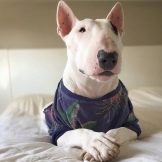
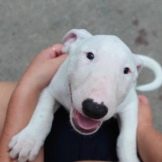

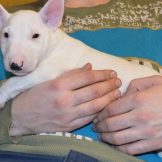
What to feed?
There are two options for feeding miniature bull terriers: natural food and prepared industrial feeds. It should be noted that most breeders choose the second option - it is more balanced, has all the necessary vitamins, no need to waste time making it. In addition, it is believed that boules grow and develop much better on prepared food. However, there are some nuances.
- Only premium feeds are suitable for feeding miniature bull terriers. High-quality feeds are more difficult to find, in addition, they are much more expensive than conventional products.
- Ready-made feeds are balanced, however, diversifying such a diet is extremely difficult. In addition, the transition from one feed to another can be very problematic and long, especially for a young pet.
- Even when choosing high-quality feeds, you cannot be 100% sure of what it consists of.
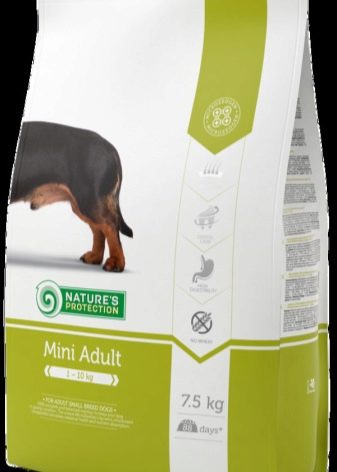
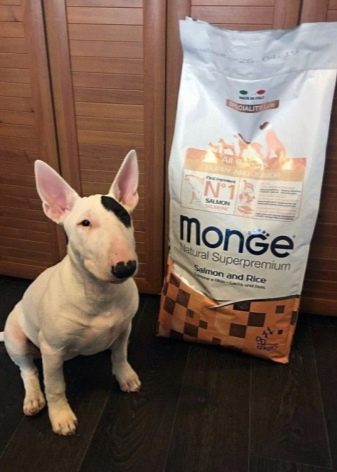
The choice of feed type depends only on the financial capabilities of the owner and the limited time.
When choosing a natural type of feeding, the main condition is the creation of a complete and balanced diet. You must constantly monitor the composition of such food and regulate the amount of proteins, fats and carbohydrates in it. The basis of such food can be raw or boiled meat (most importantly, with a low proportion of fat), offal or some sausages. The rest of the diet is plant foods and supplements. As a plant food, it is recommended to use cereals on water (rice, millet, buckwheat, semolina). Fermented milk products, sea fish (as a substitute for meat), quail eggs, vegetables (celery, carrots, cabbage) are served as additives.
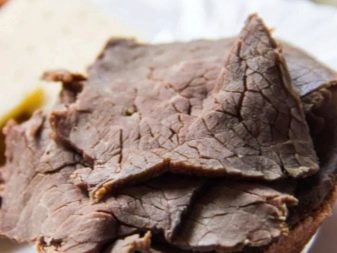
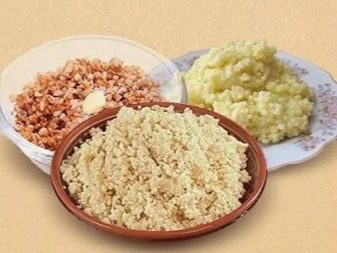
Vitamins and minerals must be added to such a diet, because in natural food, even despite its nutritional value, there may not be a sufficient amount of necessary elements. Before buying any vitamins, consult your veterinarian.
Regardless of what type of food you choose, you should adhere to the following recommendations when feeding mini-bulls.
- Perform regular feeding procedures at approximately the same time. So the pet’s body will get used to your schedule and learn how to support itself during breaks without food. If the dog begs for food outside of the feeding period, you can use special brain or vitamin bones to satisfy her hunger.
- Do not forget that nutrition depends on the breed of dogs as much as on the age of a particular pet. In their youth, dogs need food with a huge amount of vitamins. At a more mature age - hearty food, which provides the pet's body with energy for the whole day. Often the regularity and servings of food for dogs of a certain age are indicated on the packaging of the feed.
- Often mini-boules cannot independently control those volumes of food that their body is able to process. The peculiarity of the nutrition of these dogs is that their body needs saturated feeding almost up to a year old. That is why feeding should be carried out in small portions at least 4 times a day.Over time, the number of innings is reduced to 2 times a day. Do not overfeed your pet, in the case of bulls, obesity can extremely negatively affect the work of their entire body.
- Eliminate all elements of human food from the diet: salted, spicy, smoked, fried foods. In addition, sweets (in any form), fatty foods, and milk should not be included in the diet.
- Constant access to clean water is a prerequisite for any type of feeding.
- Since dogs should be walked just before eating, the pet will be on the street in a state of food search. Often found on the street is harmful and dangerous to health, and therefore from a young age wean the dog to take any things from the street in his mouth.
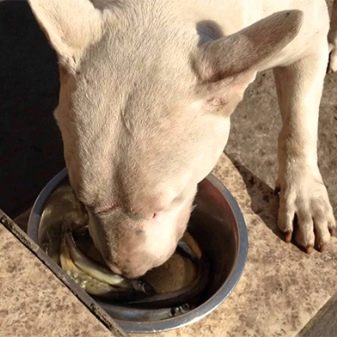

How to care?
Caring for these dogs does not differ in any particular complexity, even an inexperienced owner can cope with it. Due to the short coat, the main part of the care ends precisely with normal hygiene. These dogs have short and stiff hair with virtually no undercoat. There is no molting as such, however, to get rid of dead hair, you need to regularly use combs or brushes with hard teeth. If the hair of these dogs repels moisture and dirt remarkably, then the dust on it lingers perfectly, but combing will help get rid of it. Combing should be done at least 1 time per week.
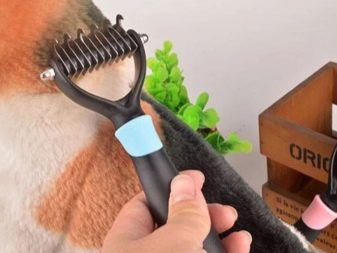
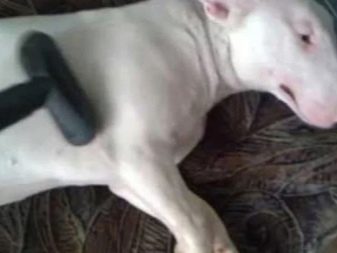
These dogs adore active pastime, and therefore their claws usually grind themselves on walks and during training. However, in the winter seasons due to weak activity, the dog's claws can grow back and cause them discomfort. In order to get rid of painful processes, it is advised to cut them with a clipper if necessary. When trimming colorless claws, you need to be guided by the place where the red stripe ends inside the claw, in the case of dark claws - trim just below the claw curvature.
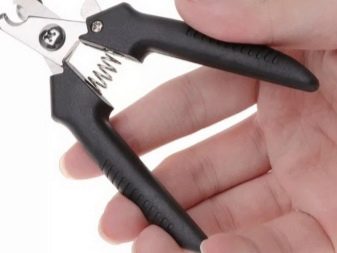
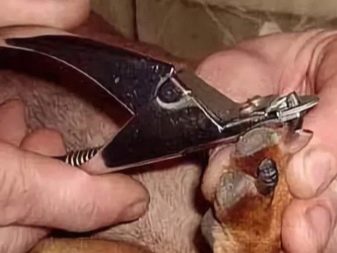
These dogs do not need frequent washing with shampoos and lotions, they will be enough to bathe 4 times a year. This is not the breed of dog that will throw itself into dirty puddles or into the water, mini-bulls - born purebreds. In order for the dog to dry faster, it is advised to carefully wipe it with a towel - so you will reduce the chance of a cold. On the strong and powerful teeth of miniature bull terriers, tartar and plaque regularly accumulate. In order to prevent its formation, you need to brush your dog’s teeth with a special paste at least 1 time per week or give vegetables that clean them from plaque - tomatoes, for example.
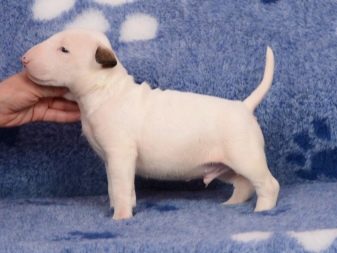

Regularly monitor the hygiene of your animal’s large ears. Wipe them with cotton buds at least once a week and inspect for inflammation. It is easy to guess the condition of the ears by smell, as well as by the color of sulfur inside the sink. For prevention and protection, it is recommended that at least 1 time per month instill in the ears of the animal special solutions from infections.
Do not forget about treating your pet from skin parasites and helminths (worms). For this, special solutions and lotions for skin treatment are purchased. Anti-worm drugs are usually given to dogs before meals. Do not forget to check with your veterinarian if you need to give this or that medicine against worms. Do not forget about regular vaccinations. The animal must be vaccinated before the first walk on the street and before the first contact with other pets.

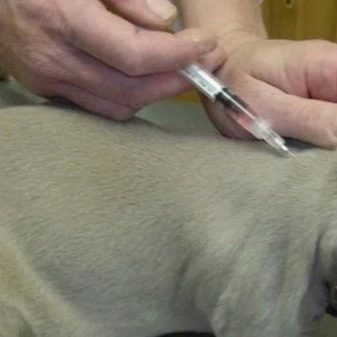
The main aspect of mini-bull content is regular physical activity. The owners of these dogs should provide them with regular walks for a surge of energy. If up to 8 months it should be regular walks with minimal loads (up to about a year, the skeleton and muscular system of these dogs are actively formed), then after 10 months you must provide your pet with full hour training with different simulators and exercises.
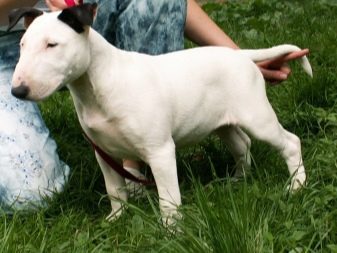
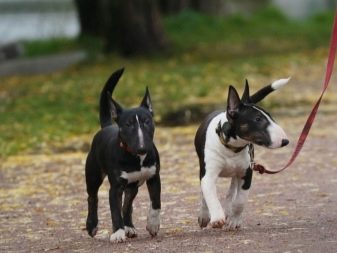
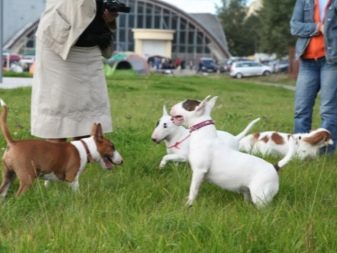
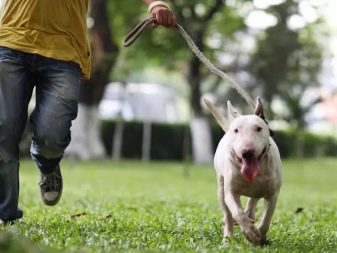
In the autumn and winter season, you need to walk these dogs only in clothes or blankets - they have too much chance of catching a cold or earning pneumonia. On the day you should provide at least 2 full walks before eating. If you have accustomed the body of an adult pet to intensive training, it will not be easy to wean him, and a long absence of stress will lead to obesity. Keep in mind that most hygiene procedures will not give your dog much pleasure. That is why it is worth accustoming a dog to them from childhood.
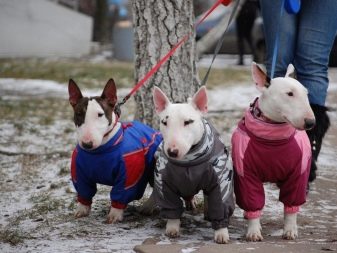

Parenting and training
The owner of any bull terrier has only one main task in education - to form the correct authority of the leader. Education should be carried out from the very first day of the appearance of the puppy in the house. Remember, if one day you give a pet an indulgence or allow something to be done, it will be very difficult to wean it from it. To create the right authority in the eyes of a miniature bull terrier, adhere to the following rules.
- The place of the dog (aviary, lounger, house on the territory) is its permanent place of sleep. Do not let your pet sleep wherever he wants.
- First you start eating, and then give it to the dog. As a rule, dogs eat faster than people, so if you finish eating later - claims for food from the table will not be avoided.
- Try to give encouragements and goodies only for the execution of commands, otherwise the dog will lose motivation to carry out your instructions.
- When walking, always keep your pet near you. You are the first to enter the room always, and then the pet. So you show the difference between you and your priority.
- Avoid screaming and beating, express your attitude to the dog with the help of intonation and timbre. Pronounce the commands clearly and confidently.
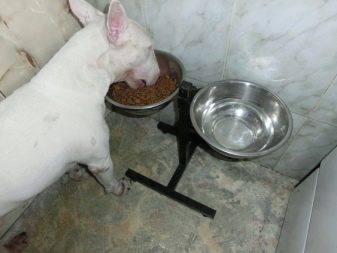

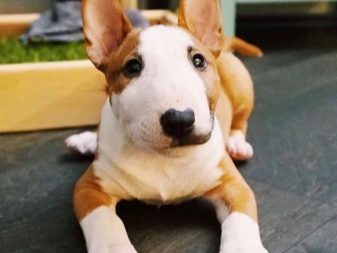
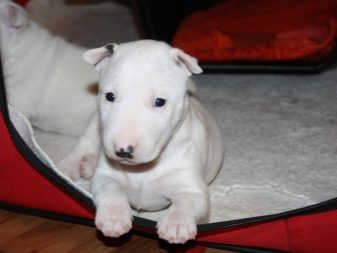
See how to properly educate a miniature bull terrier in the next video.
